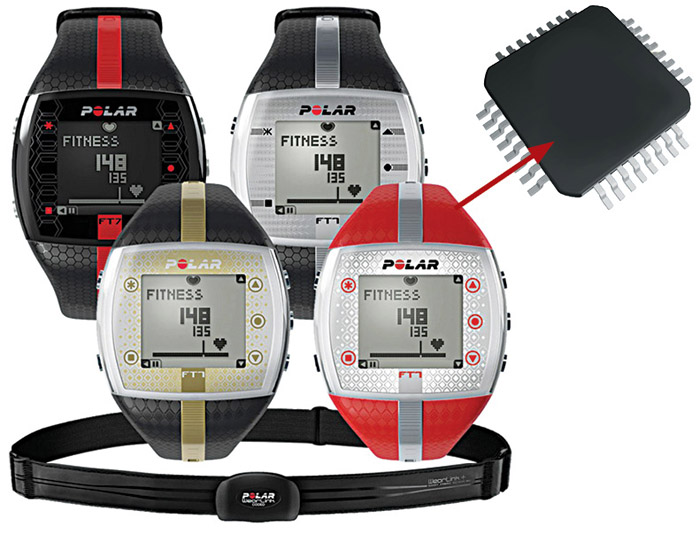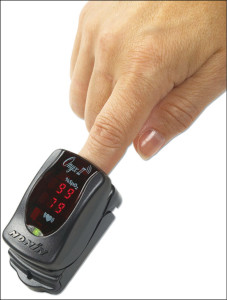
MEMS is the technology behind various types of silicon sensors and nano pumps. Consumer sensor technologies from STMicroelectronics include multiple-axis motion and orientation, compass, pressure, temperature, sound (microphone) sensors as well as biological and molecular compounds.
In some portable medical-electronic systems, the MCU needs to be able to affect the outside world. This can be accomplished via motors, linear actuators, pumps, fans, lamps and other components that are connected to the MCU. Depending on the amount of power involved, some of these components may have a field-effect transistor (FET) or other power-control device between them and the MCU.
Most portable medical-electronic devices include some means of communicating with the user. This can be via lights and buttons, an LCD or touch-screen, audio cues including speech, or through a remote interface.
Practically, all of these portable products need a low-power MCU to take commands from the user or operator and provide readings and status updates. Because almost all of these products run on batteries, a key consideration is lengthening the battery life. Products vary in the battery lifetime required, but two to ten years between battery changes is not unusual.
Robust data processing and a wired or wireless communication interface are important. Highly integrated analogue components are required to condition and convert the signals into the digital domain so that these can be processed and interpreted. Portable medical equipment can greatly benefit from the level of integration that the latest SoCs with on-board MCUs provide.
Addressing the key concerns

Semiconductor manufacturers are coming up with innovative solutions to make medical devices portable, low-power, safe, secure, reliable and connected.
Portability. The device should be easy to use wherever the patient happens to be. Here, one very important factor is the physical size of the device, which is partly determined by the size of components used inside.
Semiconductor manufacturers are working hard to reduce both the size and power requirement of portable medical-electronic devices. Consider, for example, accelerometers, which are used in pedometers and blood pressure meters. Devices such as the ADXL345 3-axis accelerometer can operate with a typical power drain of only 25 µA in a 3×5×1mm3 package.
Standby current is especially important in many applications to conserve battery life. Devices such as the ADXL345 can run with standby power levels of 0.1 µA, giving a couple of years of battery life in low-duty-cycle applications.
Power management. It is critical for medical devices to consume minimal power, especially if these are intended to be worn on or implanted inside the human body. The power consumption of medical devices can affect the implant’s lifetime, the amount of heat generated by the device, battery weight and battery cost.
Microcontrollers and other ICs for medical applications achieve low power consumption in a number of ways. Multiple low-power modes, for instance, give designers the flexibility to turn some or all of the MCU functions on or off.
The MCU must support low power in active mode, standby mode and reduced time in an active state. The portable device, and thus the MCU, will be in ‘off’ or lower power state most of the time. However, the device also needs to maintain some sort of function such as clock/calendar or alarm even when not in use. Thus minimising its awake time is the key to extending the battery life. The MCU design should be able to wake the clock and analogue circuits for fast measurements and then allow the MCU to settle back to a low-power state.
A range of ultra-low-power microcontrollers (STM32L and STM8L series from STMicroelectronics) based on a proprietary 130nm ultra-low-leakage process technology are available. These minimise overall energy consumption without compromising on speed and functionality.
In parallel with the drive towards lower current draw, the supply rails required by medical devices are also coming down. While this is relatively easy to achieve in digital circuits as the industry follows the Moore’s Law curve, it is tough for mixed-signal measurement systems. Problems with leakage and signal-to-noise ratio abound. These problems, however, are gradually being brought under control, thus easing the design of the overall power management system.
Connectivity. It is becoming more common for portable medical-electronic devices to communicate with each other or with other devices, either point-to-point or over a network. Connected devices create a number of new capabilities. The simplest may be the one where a device is able to transfer data to a personal computer for storage or analysis. This has so far been done via serial bus or infrared, but latest devices use USB.










